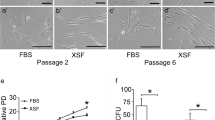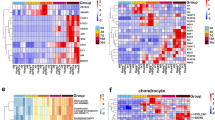Abstract
We successfully established a chordoma cell line, designated TSK-CHO1, derived from the clival chordoma. Currently, there is only one skull base chordoma cell line, UM-chor1, freely available to researchers. The established TSK-CHO1 cells were neoplastic, exhibited pleomorphic features, and secreted brachyury, as revealed by immunocytochemical staining or ELISA of conditioned medium (CM). Cells also secreted SOX9, which enhanced brachyury production. The CM of TSK-CHO1 cells promoted the production of hyaluronic acid and type II collagen during differentiation of human dental pulp stem cells (DPSCs) into fibrocartilage cells. Culture of DPSC pellets in a growth medium supplemented with 10% CM of TSK-CHO1 cells for 2 weeks resulted in the induction of fibrocartilage tissue under normoxic conditions. Brachyury produced by TSK-CHO1 cells promoted the production of collagen type II, peculiar to cartilage, in a dose-dependent manner. The newly established skull base chordoma cell line, TSK-CHO1, is expected to be used for elucidating the pathogenesis of skull base chordoma and for investigating the mechanism underlying the production of fibrocartilage.







Similar content being viewed by others
References
Fletcher C. World health organization classification of tumors. Pathology and genetics of tumors of soft tissue and bone. Lyon: IARC Press; 2002.
Smoll NR, Gautschi OP, Radovanovic I, Schaller K, Weber DC. Incidence and relative survival of chordomas: the standardized mortality ratio and the impact of chordomas on a population. Cancer. 2013;119:2029–37.
George B, Bresson D, Herman P, Froelich S. Chordomas: a review. Neurosurg Clin N Am. 2015;26:437–52.
Yakkioui Y, van Overbeeke JJ, Santegoeds R, van Engeland M, Temel Y. Chordoma: the entity. Biochim Biophys Acta. 2014;1846:655–69.
McMaster ML, Goldstein AM, Bromley CM, Ishibe N, Parry DM. Chordoma: incidence and survival patterns in the United States, 1973–1995. Cancer Causes Control. 2001;12:1–11.
Fung V, Calugaru V, Bolle S, Mammar H, Alapetite C, Maingon P, De Marzi L, Froelich S, Habrand JL, Dendale R, Noël G, Feuvret L. Proton beam therapy for skull base chordomas in 106 patients: a dose adaptive radiation protocol. Radiother Oncol. 2018;128:198–202.
Hayashi Y, Mizumoto M, Akutsu H, Takano S, Matsumura A, Okumura T, Kawabe T, Zenkoh J, Sakurai H, Tsuboi K. Hyperfractionated high-dose proton beam radiotherapy for clival chordomas after surgical removal. Br J Radiol. 2016;89:20151051.
Uhl M, Mattke M, Welzel T, Roeder F, Oelmann J, Habl G, Jensen A, Ellerbrock M, Jäkel O, Haberer T, Herfarth K, Debus J. Highly effective treatment of skull base chordoma with carbon ion irradiation using a raster scan technique in 155 patients: first long-term results. Cancer. 2014;120:3410–7.
Hsu W, Mohyeldin A, Shah SR, ap Rhys CM, Johnson LF, Sedora-Roman NI, Kosztowski TA, Awad OA, McCarthy EF, Loeb DM, Wolinsky JP, Gokaslan ZL, Quiñones-Hinojosa A. Generation of chordoma cell line JHC7 and the identification of brachyury as a novel molecular target. J Neurosurg. 2011;115:760–9.
Rinner B, Froehlich EV, Buerger K, Knausz H, Lohberger B, Scheipl S, Fischer C, Leithner A, Guelly C, Trajanoski S, Szuhai K, Liegl B. Establishment and detailed functional and molecular genetic characterisation of a novel sacral chordoma cell line, MUG-Chor1. Int J Oncol. 2012;40:443–51.
Liu X, Nielsen GP, Rosenberg AE, Waterman PR, Yang W, Choy E, Sassi S, Yang S, Harmon DC, Yang C, Schwab JH, Kobayashi E, Mankin HJ, Xavier R, Weissleder R, Duan Z, Hornicek FJ. Establishment and characterization of a novel chordoma cell line: CH22. J Orthop Res. 2012;30:1666–73.
Gellner V, Tomazic PV, Lohberger B, Meditz K, Heitzer E, Mokry M, Koele W, Leithner A, Liegl-Atzwanger B, Rinner B. Establishment of clival chordoma cell line MUG-CC1 and lymphoblastoid cells as a model for potential new treatment strategies [sci rep:24195]. Sci Rep. 2016;6:24195.
Owen JH, Komarck CM, Wang AC, Abuzeid WM, Keep RF, McKean EL, Sullivan S, Fan X, Prince MEP. UM-Chor1: establishment and characterization of the first validated clival chordoma cell line. J Neurosurg. 2018;128:701–9.
Bosotti R, Magnaghi P, Di Bella S, Cozzi L, Cusi C, Bozzi F, Beltrami N, Carapezza G, Ballinari D, Amboldi N, Lupi R, Somaschini A, Raddrizzani L, Salom B, Galvani A, Stacchiotti S, Tamborini E, Isacchi A. Establishment and genomic characterization of the new chordoma cell line Chor-IN-1. Sci Rep. 2017;7:9226.
Brüderlein S, Sommer JB, Meltzer PS, Li S, Osada T, Ng D, Möller P, Alcorta DA, Kelley MJ. Molecular characterization of putative chordoma cell lines. Sarcoma. 2010;2010:630129.
Nibu Y, José-Edwards DS, Di Gregorio A. From notochord formation to hereditary chordoma: the many roles of brachyury. BioMed Res Int. 2013;2013:826435.
Vujovic S, Henderson S, Presneau N, Odell E, Jacques TS, Tirabosco R, Boshoff C, Flanagan AM. Brachyury, a crucial regulator of notochordal development, is a novel biomarker for chordomas. J Pathol. 2006;209:157–65.
Yang XR, Ng D, Alcorta DA, Liebsch NJ, Sheridan E, Li S, Goldstein AM, Parry DM, Kelley MJ. T (brachyury) gene duplication confers major susceptibility to familial chordoma. Nat Genet. 2009;41:1176–8.
Sun X, Hornicek F, Schwab JH. Chordoma: an update on the pathophysiology and molecular mechanisms. Curr Rev Musculoskelet Med. 2015;8:344–52.
Jaffe HL. Tumors and tumorous conditions of the bones and joints. Acad Med. 1959;34:72.
Casagrande L, Cordeiro MM, Nör SA, Nör JE. Dental pulp stem cells in regenerative dentistry. Odontology. 2011;99:1–7.
Nuti N, Corallo C, Chan BM, Ferrari M, Gerami-Naini B. Multipotent differentiation of human dental pulp stem cells: a literature review. Stem Cell Rev Rep. 2016;12:511–23.
Capes-Davis A, Reid YA, Kline MC, Storts DR, Strauss E, Dirks WG, Drexler HG, MacLeod RA, Sykes G, Kohara A, Nakamura Y, Elmore E, Nims RW, Alston-Roberts C, Barallon R, Los GV, Nardone RM, Price PJ, Steuer A, Thomson J, Masters JR, Kerrigan L. Match criteria for human cell line authentication: where do we draw the line? Int J Cancer. 2013;132:2510–9.
Watanabe M, Ohyama A, Ishikawa H, Tanaka A. Three-dimensional bone formation including vascular networks derived from dental pulp stem cells in vitro. Hum Cell. 2019;32:114–24.
Fawcett DW. Bloom and Fawcett a textbook of histology. 12th ed. Oxford: Oxford University Press; 1994. p. 191.
Hara T, Akutsu H, Yamamoto T, Tanaka S, Yasuda M, Takano S, Kino H, Miyamoto H, Matsumura A. Combined endoscopic endonasal and transoral surgery for a chordoma in the whole clivus with marked caudal extension. Oper Neurosurg (Hagerstown). 2018;14:463–4.
Yamaguchi T, Imada H, Iida S, Szuhai K. Notochordal tumors: an update on molecular pathology with therapeutic implications. Surg Pathol Clin. 2017;10:637–56.
DeComas AM, Penfornis P, Harris MR, Meyer MS, Pochampally RR. Derivation and characterization of an extra-axial chordoma cell line (EACH-1) from a scapular tumor. J Bone Jt Surg Am. 2010;92:1231–40.
Kim JY, Lee J, Koh JS, Park MJ, Chang UK. Establishment and characterization of a chordoma cell line from the tissue of a patient with dedifferentiated-type chordoma. J Neurosurg Spine. 2016;25:626–35.
Scheil S, Brüderlein S, Liehr T, Starke H, Herms J, Schulte M, Möller P. Genome-wide analysis of sixteen chordomas by comparative genomic hybridization and cytogenetics of the first human chordoma cell line, U-CH1. Genes Chromosom Cancer. 2001;32:203–11.
Dutra EH, Lima A, Nanda R, Yadav SMHOB. PTH [1-34] induced differentiation and mineralization of mandibular condylar cartilage. Sci Rep. 2017;7:3226.
Murabayashi D, Mochizuki M, Tamaki Y, Nakahara T. Practical methods for handling human periodontal ligament stem cells in serum-free and serum-containing culture conditions under hypoxia: implications for regenerative medicine. Hum Cell. 2017;30:169–80.
Hoffmann A, Czichos S, Kaps C, Bächner D, Mayer H, Kurkalli BG, Zilberman Y, Turgeman G, Pelled G, Gross G, Gazit D. The T-box transcription factor brachyury mediates cartilage development in mesenchymal stem cell line C3H10T1/2. J Cell Sci. 2002;115:769–81.
Uusitalo H, Hiltunen A, Ahonen M, Gao TJ, Lefebvre V, Harley V, Kähäri VM, Vuorio E. Accelerated up-regulation of L-Sox5, Sox6, and Sox9 by BMP-2 gene transfer during murine fracture healing. J Bone Miner Res. 2001;16:1837–45.
Acknowledgements
This work was supported in part by a Grant-in-Aid for Scientific Research from the Ministry of Education, Culture, Sports, Science, and Technology of Japan (no. 18K08987 to S.T. and no. 21K16625 to H.K.), the Japan Brain Foundation (to S.T.), and the Japanese Foundation for Multidisciplinary Treatment of Cancer (to S.T.).
Funding
Not applicable.
Author information
Authors and Affiliations
Corresponding author
Ethics declarations
Conflict of interest
The authors declare no conflicts of interest.
Ethical approval
The study was approved by the Clinical Ethics Committee of the University of Tsukuba Hospital. Approval number is R01-232, H29-173, R01-178.
Informed consent
The informed consent was provided in writing to the patient and obtained.
Additional information
Publisher's Note
Springer Nature remains neutral with regard to jurisdictional claims in published maps and institutional affiliations.
Supplementary Information
Below is the link to the electronic supplementary material.
Rights and permissions
About this article
Cite this article
Kino, H., Akutsu, H., Ishikawa, H. et al. Inducing substances for chondrogenic differentiation of dental pulp stem cells in the conditioned medium of a novel chordoma cell line. Human Cell 35, 745–755 (2022). https://doi.org/10.1007/s13577-021-00662-5
Received:
Accepted:
Published:
Issue Date:
DOI: https://doi.org/10.1007/s13577-021-00662-5




